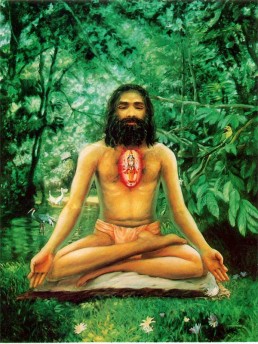
आत्मसंयमयोग
Dhyana-yoga - The Science of Self Realization
This chapter provides practical methods of meditation for one who has purified the mind by diligently engaging in karma-yoga described in the previous chapters. For such a seeker, a life of contemplation is suggested along with an assurance that the path of meditation inevitably leads to the ultimate goal of Realization whether it be in the current life or a future one. Below are the main themes of Chapter 6:
Verses 1 - 9, 16, 17
Bahiraṅga-sādhanā
Verses 10 - 15
Antaraṅga-sādhanā
Verses 18 - 32
Arjuna's change of mind, leading to attachment (rāga)
Verses 33 - 36
Dhyāna-pratibandha and parihāra
Verses 37 - 45
Yogabhraṣṭa
Verses 46 - 47
Yogistuti (Praise of the yogī)
Gita Chapter 6 - 47 Verses
Chapter 6 - 47 Verses
Commentary by Swami Paramarthananda
Background
Lord Kṛṣṇa introduced the topic of meditation towards the end of the last chapter. Being an important topic, Kṛṣṇa spends almost the whole of this chapter dealing with meditation. [Here, meditation is upon the Lord as the very Self (Ātmā) of the meditator. This is meant to assim-ilate the Self-knowledge gained from the guru’s teaching. The con-ditioning that “I am the body” will go only with the assimilation of the Self-knowledge. Assimilated Self-knowledge alone can express as ānanda.]
Kṛṣṇa talks about five important topics on meditation. They are:
1. Bahiraṅga-sādhanā — Those disciplines to be followed through-out daily life which influence one’s meditation.
2. Antaraṅga-sādhanā — Those disciplines to be followed imme-diately before meditation.
3. Dhyāna-svarūpam — Nature of meditation.
4. Dhyāna-phalam — Result of meditation.
5. Dhyāna-pratibandha-parihārau — Obstacle and remedy.
Bahiraṅga-sādhanā
At the outset, the Lord indicates the role of karmayoga in meditation by praising the karmayogī (1, 2). Karmayoga, being a conscious way of life, helps one in getting self-control. It converts an extrovert mind into a contemplative mind. Once this is achieved, one should try to lead a quieter life, because active life becomes an obstacle to meditation (3). Total detachment is the characteristic of a contemplative mind (4).
Incidentally, Kṛṣṇa highlights two important values viz. self-confidence and self-control. One who lacks these two finds himself to be an obstacle for any pursuit. On the other hand, one who enjoys the above two virtues finds himself to be supporting force in every field (5, 6). Soon he is established in the vision of the Ātmā, the vision of equality (7 to 9).
Kṛṣṇa mentions a few other disciplines also, like moderation in eating, sleeping, working, and resting (16, 17).
Antaraṅga-sādhanā
The meditator has to choose a secluded, undisturbed place for medi-tation (10). In that spiritually and physically pure place, he has to fix the seat which is neither too high nor too low, neither too soft nor too hard (11). Holding the body, neck, and head erect, he has to fix the sight on the tip of his nose, as it were (i.e., the eyes are half-closed) (13). Next, the meditator should withdraw the mind and sense organs from all other activities. The breathing also should be maintained even (refer V-27). With a calm, withdrawn, undisturbed, tension-free, and one-pointed mind, the meditator should meditate upon the Lord, the Ātmā (12, 14).
Dhyāna-svarūpam and Phalam
Meditation is nothing but abidance of the withdrawn mind in the Ātmā (18). Having given up all desires and having restrained the senses through the mind, one should gradually bring back the mind with the help of the discriminative intellect, step by step. Once the mind is made to abide in the Ātmā, there should be no other thought (25). Though the mind may get distracted, one has to bring it back from the respective fields to one’s own Ātmā (26).
(All this presupposes a clear understanding of Vedānta. Every-thing, including thoughts, is an object of the Ātmā, the Awareness. The Ātmā is not an object for me to be thought of, or to be experienced. It is the very “I”. Thus, to knock off all expectations and struggles and to abide as the Ātmā with the knowledge that “I am the Ātmā” is true meditation.)
Thus, constantly abiding in the Ātmā, the meditator comes to en-joy permanent peace which culminates in the attainment of liberation (videhamukti) (15). He enjoys an ever-abiding mind which is com-pletely satisfied with the discovery of the Ātmā (20). Since his ānanda is not sensual, it transcends all the limits. Having discovered this inner fullness, he never loses sight of his true nature (21, 27, 28). Neither does he consider any other gain to be superior, nor is he shaken by even the greatest loss (22). This infinite ānanda will never be lost be-cause this was never gained. It was veiled by the false notion that “I am sorrowful”. Once this is removed, the inner ānanda becomes evident. Thus, this is more a dissociation from sorrow rather than association (23). (This alone is known as jīvanmukti.) Seeing the Ātmā in all be-ings, and all beings in the Ātmā, he gets estabilshed in the vision of equality (29). This vision of the Ātmā alone is the vision of the Lord, because the Ātmā is not different from the Lord. Thus the meditator is ever established in the Lord inspite of his activities (30, 31). Being established in the Ātmā, he looks at all bodies including his body with the same attitude of detachment. Hence he is free from selfishness and is spontaneously established in dharma. He is a saint (32).
Dhyāna-pratibandha-parihārau
Now, Arjuna puts a question regarding an obstacle to meditation. It is the problem of mental restlessness or extrovertedness. Because of this, one finds it difficult to meditate and assimilate the Self-knowledge. This frustrates Arjuna’s mind and he asks for a solution (33, 34).
Kṛṣṇa gives two methods to solve this problem. They are de-tachment and practice. When the mind is extrovert because of desires, one has to remove it by seeing the futility of desires and their fulfill-ment. This is detachment. Even a detached mind can be restless be-cause of past habits. This has to be gradually removed by consistent practice alone. Thus, mental discipline requires determination and pa-tience (35, 36).
Still, Arjuna feels diffident and he, somehow, thinks that liber-ation is not possible in one life. He desperately asks Kṛṣṇa—“What happens to that seeker who has fallen from meditation? Does he not perish like a scattered cloud?” (Arjuna feels that the meditator has no puṇya, because he has not done any karma. He has failed to achieve liberation also. Thus being deceived of puṇya and mokṣa, he must face an unfortunate future, according to Arjuna.) Not being able to accept this, Arjuna surrenders to Kṛṣṇa seeking clarification (37 to 39).
Kṛṣṇa consoles Arjuna by asserting that a spiritual seeker can never have a bad lot (40). The very meditation is a puṇyakarma capable of giving heaven and later an ideal birth for the continuation of the spiritual pursuit. The yogabhraṣṭa (one who has fallen from the path of spirituality) is reborn in a cultured, prosperous family, or may be, even in the family of a saint (41, 42).
Having got such a birth, he gets associated with the previous wisdom at a very early age (43). Irresistibly drawn by the past habits (saṃskāras), he find his spiritual urge suddenly growing from a small flame to a huge conflagration (44). Committing his entire life to the spiritual pursuit and supported by the saṃskāras of all the previous lives, he effortlessly fulfils his mission in life (45).
Kṛṣṇa concludes this chapter by praising the meditator in general (46) and praising the meditator of Kṛṣṇa–paramātmā (Brahmātman) in particular.
Thus the sixth chapter discusses the following topics:
- Bahiraṅga-sādhanā: 1 to 9, 16, 17
- Antaraṅga-sādhanā: 10 to 15
- Dhyāna-svarūpam and dhyāna-phalam: 18 to 32
- Dhyāna-pratibandha and parihāra: 33 to 36
- Yogabhraṣṭa: 37 to 45
- Yogistuti (Praise of the yogī): 46, 47
Since the main topic here is meditation, the chapter is called Dhyāna-yoga or Ātmasaṃyama-yoga (mastery of the mind).

